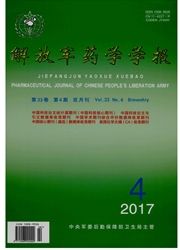

 中文摘要:
中文摘要:
目的:研究异绿原酸A在大鼠体内的生物利用度和药代动力学,为该制剂的临床应用提供参考。方法:建立大鼠血浆中异绿原酸A的HPLC检测,检测波长300 nm,流动相甲醇-0.1%磷酸水(50∶50)。考察大鼠经静脉注射(32 mg·kg^-1)与灌胃(90 mg·kg^-1)给予异绿原酸A后的血药浓度变化,利用3P97软件计算药动学参数,根据药时曲线下面积AUC0-∞和给药剂量,计算异绿原酸A的绝对生物利用度。结果:异绿原酸A在0.16~110.00 mg·L^-1线性良好(R2=0.998);质量浓度分别为0.43,6.88,55.00 mg·L^-1的异绿原酸A的提取回收率分别为(89.43±2.84)%,(93.16±3.95)%,(85.91±2.04)%;日内精密度RSD分别为11.8%,4.0%,4.0%,日间精密度RSD分别为6.5%,5.8%,5.8%。大鼠静脉注射和灌胃异绿原酸A后,异绿原酸A在大鼠体内的代谢过程均符合二室模型,消除半衰期分别为(29.49±0.75),(44.48±0.13)min,AUC0-∞分别为(355.40±32.58),(319.91±51.00)mg·min-1·L^-1。异绿原酸A在大鼠体内的绝对生物利用度30.71%。结论:异绿原酸A在大鼠体内的过程符合线性动力学过程,且代谢快、半衰期短。
 英文摘要:
英文摘要:
Objective: To study pharmacokinetics and bioavailability of isochlorogenic acid A in rats with different adiminstration way. Method: A HPLC method was developed for determination of isochlorogenic acid A in rat plasma. Intravenous and intragastric doses of 32 mg · kg^-1 and 90 mg · kg^-1 were respectively administered,the concentration of isochlorogenic acid A were determined with HPLC,detection wavelength was set at 300 nm. Pharmacokinetic parameters were calculated with 3P97 software. Absolute bioavailability of isochlorogenic acid A was calculated according to AUC0-∞and doses of isochlorogenic acid A by intravenous and intragastric administration. Result: Excellent linear relationship was obtained in the range of 0. 16-110. 00 mg·L^-1 with R2 of 0. 998. Recoveries of isochlorogenic acid A with three concentrations( 0. 43,6. 88,55. 00 mg ·L^-1) were( 89. 43 ± 2. 84) %,( 93. 16 ± 3. 95) % and( 85. 91 ± 2. 04) %. The intra-day RSD were 11. 8%,4. 0% and 4. 0%. The inter-day RSD were 6. 5%,5. 8% and 5. 8%, respectively. Metabolic processes of isochlorogenic acid A in rats fitted in with two-compartment model following intravenous and intragastric administration. Elimination half-life were( 29. 49 ± 0. 75) min and( 44. 48 ± 0. 13) min. AUC0-∞were( 355. 40 ± 32. 58),( 319. 91 ± 51. 00) mg·min^-1·L^-1. Its absolute bioavailability in rats was 30. 71%.Conclusion: Metabolic processes of isochlorogenic acid A in rats conform to linear dynamics with fast metabolism and short half-life.
 同期刊论文项目
同期刊论文项目
 同项目期刊论文
同项目期刊论文
 期刊信息
期刊信息
